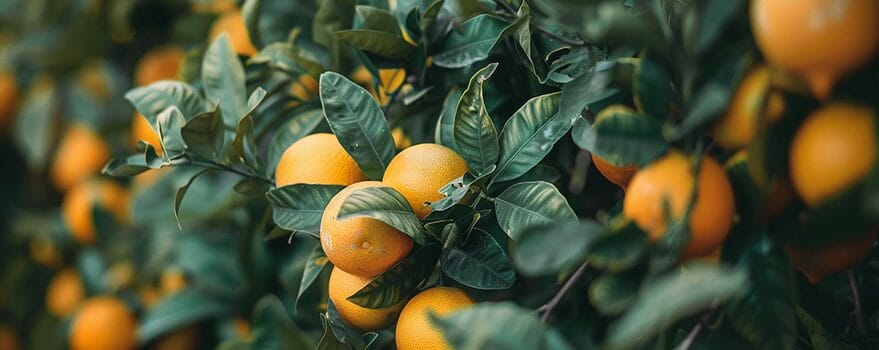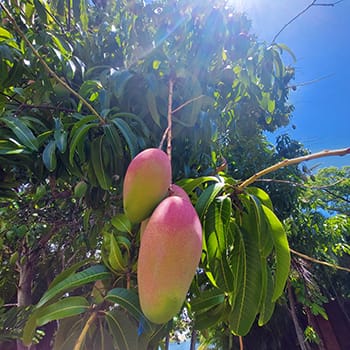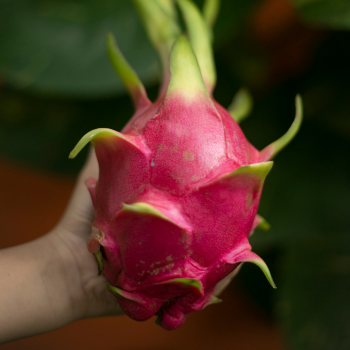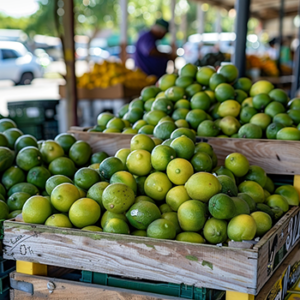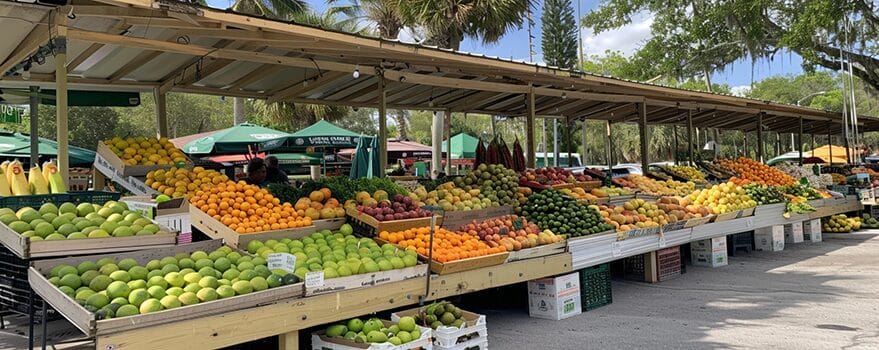
List of Fruits that Grow in Florida
This list of fruits that grow in Florida will help you determine which varieties are perfect for sourcing fresh from local farms and which ones you might be able to grow right in your backyard or even in a container garden! Florida’s climate supports a wide range of fruits, and knowing the right planting zones is essential for ensuring that each type of fruit thrives.
When you’re planning to grow fruit at home, it’s important to consider the size of each plant or tree and how often it produces—especially if you have limited space. Some fruits need lots of room and take years to mature, while others can thrive in smaller spaces and yield multiple harvests each year.
For instance, if you have a small backyard and want to grow as much fruit as possible, you might want to skip pineapple plants. While delicious, they take up around 3 feet of space each and only produce one fruit every 1 to 1.5 years! That’s a lot of space for limited fruit, especially compared to varieties that produce several times per season.
Use this guide to choose the best fruits to buy locally or grow yourself, and start enjoying Florida’s fresh, tropical flavors year-round!

Florida Planting Zones

Florida is divided into multiple planting zones, ranging from 8a in the northern regions to 11 in the southernmost parts of the state.
These zones are based on the average minimum winter temperature and are crucial for determining which plants and fruits can thrive in a particular area.
Knowing your planting zone is important when planning to grow fruits at home because it helps ensure that the plants you choose are suited to the climate in your region.
For example, tropical fruits like mangoes thrive in warmer zones (10-11), while more cold-tolerant fruits like apples can grow in cooler zones (8-9).
To find your specific zone, check out the USDA Planting Zone map USDA Planting Zone Map. This map provides valuable information about the hardiness of plants and guides you in selecting the best fruits and vegetables to grow in your area. By understanding your planting zone, you can make informed decisions, maximizing your chances of growing a successful fruit garden at home!
Citrus Fruits
Most citrus in Florida grows between Central and South Florida, and the best way to figure it out is by using planting zones. However, there are many varieties of these different types of citrus which have been adapted to grow in different zones.
When buying a citrus tree to grow at home, make sure to know what zone you live in and match it to the citrus that will grow there.
And if you have limited space, look for “dwarf” varieties of the citrus you’d like to grow.
- Oranges
Zone: 9-11
Size: Tree, 15-30 feet tall
Production: Annual; harvest in fall to winter
See my blog post on Orange Season in Florida and Best Ways to Enjoy It Grapefruits
Zone: 9-11
Size: Tree, 15-25 feet tall
Production: Annual; harvest in winter to springTangerines
Zone: 9-11
Size: Tree, 10-15 feet tall
Production: Annual; harvest in late fall to early winterLemons
Zone: 9-11
Size: Tree, 10-20 feet tall
Production: Can produce multiple times a year; main harvest in winterLimes
Zone: 10-11
Size: Small tree, 8-15 feet tall
Production: Can produce several times a year; peak in summer to early fallKumquats
Zone: 9-10
Size: Shrub or small tree, 8-15 feet tall
Production: Annual; harvest in winter
Tropical and Subtropical Fruits
- Mangoes
Zone: 10-11
Size: Large tree, 30-100 feet tall
Production: Annual; harvest in summer
See my blog on Valencia Pride Mangoes - Papayas
Zone: 10-11
Size: Tree, 6-15 feet tall
Production: Nearly continuous production year-round in warm conditions - Bananas
Zone: 9-11
Size: Herbaceous plant, 10-25 feet tall
Production: Perennial; each plant produces one bunch per season - Pineapples
Zone: 10-11
Size: Short plant, 3-5 feet wide
Production: Each plant produces one pineapple every 18-24 months - Lychees
Zone: 10-11
Size: Tree, 20-40 feet tall
Production: Annual; harvest in summer - Guavas
Zone: 9-11
Size: Shrub or small tree, 10-15 feet tall
Production: Twice per year; harvest in summer and early winter - Passion Fruit
Zone: 10-11
Size: Vine, up to 20 feet
Production: Produces multiple times a year in warm climates - Starfruit (Carambola)
Zone: 10-11
Size: Small tree, 10-20 feet tall
Production: Multiple harvests a year; peaks in late fall to early winter - Dragon Fruit (Pitaya)
Zone: 10-11
Size: Climbing cactus, 10-20 feet
Production: Several crops per year; peak in summer
See my post on Dragon Fruit Season in Florida - Mamey Sapote
Zone: 10-11
Size: Large tree, 40-60 feet tall
Production: Annual; harvest in spring to summer - Sapodilla
Zone: 10-11
Size: Tree, 30-50 feet tall
Production: Produces multiple times a year, with peak in spring - Longan
Zone: 10-11
Size: Tree, 20-40 feet tall
Production: Annual; harvest in summer - Jackfruit
Zone: 10-11
Size: Large tree, 30-70 feet tall
Production: Annual; harvest in spring and summer - Avocados
Zone: 9-11
Size: Tree, 30-60 feet tall
Production: Annual; harvest depends on variety but typically summer to fall
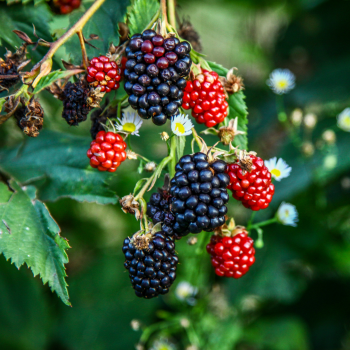

Berries
Blueberries
Zone: 8-10 (Southern highbush varieties)
Size: Shrub, 4-6 feet tall
Production: Annual; harvest in springBlackberries
Zone: 8-10
Size: Bramble, 3-5 feet tall
Production: Annual; harvest in summer
See my blog post all about Blackberry Season in Florida and see u-pick farms to visit, ideas for enjoying blackberries, a great blackberry cocktail recipe and more!Mulberries
Zone: 9-11
Size: Tree, 30-50 feet tall
Production: Annual; harvest in springSurinam Cherries
Zone: 9-11
Size: Shrub or small tree, 6-15 feet tall
Production: Multiple times a year in warm climatesStrawberry Guava
Zone: 9-11
Size: Shrub or small tree, 10-15 feet tall
Production: Twice per year; harvest in summer and winterElderberries
Zone: 8-10
Size: Shrub, 6-12 feet tall
Production: Annual; harvest in late summer
Stone Fruits
Peaches
Zone: 8-10 (low-chill varieties)
Size: Tree, 10-20 feet tall
Production: Annual; harvest in springNectarines
Zone: 8-10 (low-chill varieties)
Size: Tree, 10-20 feet tall
Production: Annual; harvest in springPlums
Zone: 8-9
Size: Tree, 10-15 feet tall
Production: Annual; harvest in spring
Figs
- Figs
Zone: 8-11
Size: Shrub or small tree, 10-20 feet tall
Production: Twice per year; main crop in summer
Grapes
Muscadine Grapes
Zone: 7-10
Size: Vine, can grow up to 20 feet
Production: Annual; harvest in late summerScuppernong Grapes
Zone: 7-10
Size: Vine, up to 20 feet
Production: Annual; harvest in late summer
Other Unique Fruits
Loquats
Zone: 8-10
Size: Tree, 10-20 feet tall
Production: Annual; harvest in late winter to springPomegranates
Zone: 8-11
Size: Shrub or small tree, 6-15 feet tall
Production: Annual; harvest in late summer to fallPawpaws
Zone: 8-9
Size: Small tree, 15-20 feet tall
Production: Annual; harvest in late summerJaboticaba
Zone: 9-11
Size: Small tree, 10-15 feet tall
Production: Multiple times a year, with peaks in spring and fallAcerola Cherries
Zone: 10-11
Size: Shrub or small tree, 6-12 feet tall
Production: Multiple times a year in warm climatesSoursop
Zone: 10-11
Size: Tree, 20-30 feet tall
Production: Annual; harvest in summerTamarind
Zone: 10-11
Size: Large tree, 40-60 feet tall
Production: Annual; harvest in late spring to early summerMiracle Fruit
Zone: 9-11
Size: Shrub, 4-5 feet tall
Production: Multiple times a year, with peak in summer
Exploring Florida’s local fruits is a delicious way to support health and local farmers, all while discovering new flavors. Visiting local farms or enjoying a fun day out at a U-pick farm allows you to get the freshest, in-season produce and connect directly with the growers who nurture these fruits.
U-picks are perfect for families, friends, and anyone looking to experience Florida’s harvest firsthand—plus, there’s nothing like biting into a freshly picked fruit!
If you’re considering growing fruit at home, even a small space can yield rewarding results. Many fruits on this list thrive in container gardens or compact spaces, giving you the chance to enjoy your own harvest without needing a large yard. With a little planning, you can grow a surprising variety of fruits right on your porch or patio.
Whether you buy from local farms or grow your own, adding more fresh, local fruit to your routine is a great way to savor Florida’s natural bounty. Enjoy the journey of tasting, growing, and supporting local agriculture—your taste buds and community will thank you!
As an Amazon Associate I earn from qualifying purchases at no additional cost to you.

